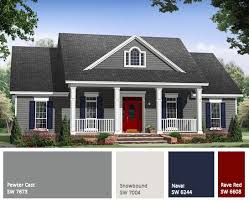House just up? Here’s how to select the right exterior color
 When you have just acquired a new house, it is common knowledge that you need to spruce it up so that it can fit your taste while still keeping in touch with the exterior color palette of the neighborhood.
When you have just acquired a new house, it is common knowledge that you need to spruce it up so that it can fit your taste while still keeping in touch with the exterior color palette of the neighborhood.
If you think splashing any random color on the siding and trim will do, you couldn’t be any wider off the mark. Here are some tips that you can utilize so that you do not have one big and expensive mistake on your hands.
Take into account the architectural style of the house
Ever walked down the block and seen a stone gothic house painted lime green? Didn’t think so. This is because this kind of color was not utilized by the people in that era to paint their houses. You should, therefore, be mindful of the day from which your house originates or wants to emulate.
It is not set in stone (see what I did there?) to adhere strictly to the color scheme of the time, but these colors should be used as the starting point before you can stamp your personality onto the exterior of your house.
What colors have your neighbors used?
Before you even pop open the can of paint, you should check out the colors that your neighbors put up on the trims and sidings of their houses. The houses might look different, but they are following a certain theme, whether they know it or not.
You should, therefore, adhere to the color theme that has been used by the neighborhood. This, however, does not mean that you use the exact same color that has been applied to the houses between which yours is sandwiched.
If the neighborhood has gone with warm colors for their houses, you should not come around and introduce a typically cool color paint to the exterior of your house. You should select another warm color that will blend in just fine, but also different enough that your house does not lose its personality.
Make that color pop!
Pop, you say? Yes, pop! Slathering the entire house in one color makes it look bland. It is for this reason that the siding gets a different color and so does the trim and the accents. If you have gone with a strong gray for the siding, the trim should be of a livelier tone like a classic white.
This contrast between the two colors makes the gray appealing on the exterior of the house. With the accents – the doors and window frames – you can now make a statement that will differentiate your house from the other gray ones further down the block.
The accents can receive a shouting color like red. The entire ensemble of colors will bring your whole house exterior to life.
Picking out the paint
When you are picking out the paint of the color you have decided upon, it is always wise to note that the color portrayed on the paint chips will not always translate directly on the wall as it appears.
It is, therefore, prudent to paint test patches to see how it will appear at different times of the day and if it is the same tone as you like.
With all this in hand, I guess it is time to get out the roller and paint your house to life.
